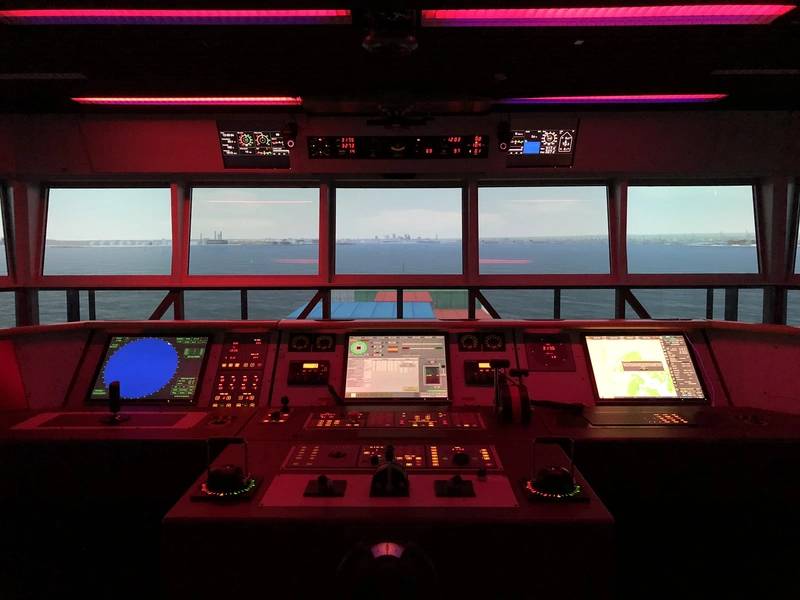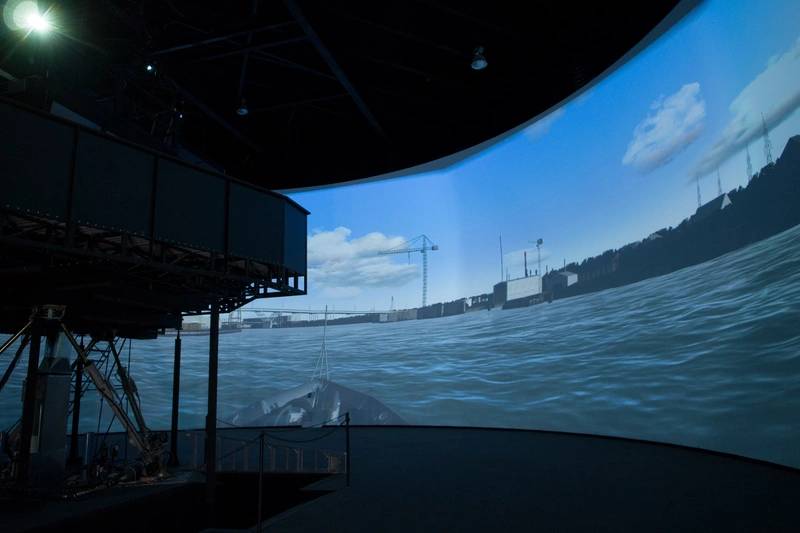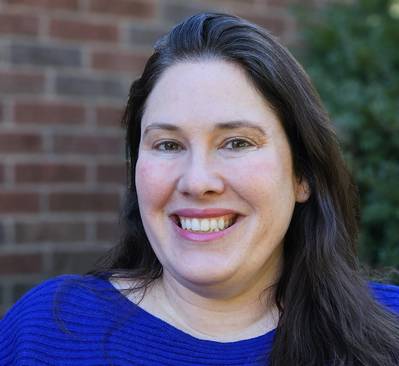Insights: Catherine Gianelloni, MITAGS
Catherine Gianelloni sailed with the International Organization of Masters, Mates & Pilots (IOMM&P) for about 10 years after graduating from the U.S. Merchant Marine Academy in 2009. But in between times at sea, she would help out at the MITAGS (Maritime Institute of Technology and Graduate Studies). Operating simulators evolved into teaching opportunities, and Gianelloni took a full-time position in 2012. “Because we are the union school, I was allowed to take breaks—leave of absences—to go out and sail. I managed to maintain my license and even upgrade it while I was an active instructor,” Gianelloni said.
In January of this year, Gianelloni took over as Academic Director at MITAGS’ East Coast campus in Linthicum Heights, Md. “I basically manage the resources and lead the school side of the East Coast campus. I make sure that all the courses are ready to go, the instructors are prepared and handle the day-to-day, boots-on-the-ground activity.”
Gianelloni said MITAGS’ mission is to drive excellence and safety to strengthen our communities. Its goal: provide top-quality maritime education and serve its IOMM&P trust members. “Beyond that, we want to help mariners gain and maintain their license, and we want to do so in an environment that is quality,” Gianelloni added.
Gianelloni said the abundance of hands-on experience found at MITAGS is a key piece of the quality equation. Robust experience, foundational knowledge and recency in sailing allow instructors and representatives at the school to discuss real world current issues with students, she explained. “We can have over 150 years of sea service sitting at the lunch table at any point in time, and it really creates an interesting and dynamic environment,” Gianelloni said, referring to the instructional staff.
“We are not in any way a certificate farm. The students really engage with us. We make sure instructors are up-to-date on all the current technology, and we transition with the industry,” Gianelloni said.
 (Photo: MITAGS)
(Photo: MITAGS)
Industry in transition
The rapidly changing landscape at sea and aboard modern vessels presents a challenge for today’s maritime training providers. “Our regulatory requirements don't always marry up well to modern advances. So, we teach mariners what they need to know by regulation, but then also help them take that same skillset and apply it to the ever-changing environment,” Gianelloni said. “It’s a balancing act between making sure that we meet regulatory requirements while also preparing our mariners to be modern, up to date and able to problem solve.”
MITAGS has no problem keeping abreast of current trends. “Most of the students that walk through the school are actively sailing mariners. So, we are getting constant feedback about what changes are actually being implemented in the field. We do have at least a dozen actively sailing instructors who are licensed mariners; they are still going out to sea and then coming here to teach during their breaks from sea. That enables us to stay right on top of changes that are happening.”
In addition, MITAGS’ unique relationship with the union leaves a door open for dialog with stakeholders. “Vessel operators who use union employment are in a constant feedback loop with us about what their current training needs are,” Gianelloni said. “We go above and beyond the regulatory needs. MITAGS has over 200 courses in our catalog, and not all of them are U.S. Coast Guard approved. What that means is we do the regulatory training and then we are in constant discussion with companies to provide any specific training that they need for their sector, their part of the industry or their staff in general.
“By partnering with these companies, both through the union and outside of the union, we get a feel for what their training needs are and then adjust to them. Regulatory classes are regulatory classes; there's no real adjustment there. But a lot of companies invest in their mariners by giving company-specific training, which shows us how these companies are being proactive in tracking trends and analyzing what would suit their mariners best, beyond regulatory requirements.”
 (Photo: MITAGS)
(Photo: MITAGS)
Workforce gaps
It’s well known that the maritime industry is among those dealing with a shortage of qualified personnel. MITAGS offers several pathways that aim to help fill some of the workforce gaps, including programs approved by the U.S. Coast Guard, State of Washington Workforce Training and Education Board and Maryland Higher Education Commission.
“We have programs designed to help people both gain an original license/credential and upgrade the license/credential that they have. These programs sometimes last as long as two and a half years, but our maritime apprentice program basically offers a fast track into the industry,” Gianelloni said. “These programs are incredibly successful.”
MITAGS guides students through in-classroom training and helps arrange opportunities for gaining all-important practical knowledge at sea. By the end, a student can take a license prep course before sitting for an unlimited tonnage third mate license exam.
“The pathway for a mariner to both enter the field and then raise their license is confusing and sometimes very overwhelming. And unless we're getting the students directly from a state maritime academy—which is also a phenomenal option—it can be very hard to enter adult education without a clear roadmap.”
Gianelloni said MITAGS actively works to remove barriers that often prevent newcomers from entering the workforce—including financial obstacles. “It's a significant ask of somebody to dedicate two years without any type of sponsorship,” Gianelloni said, adding that MITAGS tries to secure funds to cover as much of the training as possible or arrange situations where the funds are forgiven after so many years. “In this environment it is unreasonable to ask somebody to get paid cadet wages for two years while they go through the program.”
“We partner with a lot of organizations to try and sponsor their mariners through the program. They want the qualified worker on the tail end, and we can help provide what they need. And what we need is time on board their vessels to train these mariners in the practical application.”
 (Photo: MITAGS)
(Photo: MITAGS)
Simulator strength
Asked about some of the things that set MITAGS apart from other training providers, Gianelloni gave a shoutout to the organization’s team of more than 75 expert instructors. “We bring in the specialists who know the material through and through.”
Gianelloni was also quick to point out the organization’s simulation department in particular. “It’s our jewel, in my opinion,” she said. “We do exercises that we just don't see done anywhere else.”
In addition to training mariners in regulated courses, MITAGS performs a lot of operational research for groups such as pilot organizations, domestic companies or even foreign governments. “Our operational research literally reaches around the world,” Gianelloni said. “We operate our simulators on a level that is not really comparable to other schools. We test the boundaries of our simulators and the simulator manufactures.”
Through grants, MITAGS is currently in the process of installing 12 new simulators on campus that will help it to push the boundaries further in areas such as virtual reality (VR) simulation and dynamic positioning simulation, for example.
The organization’s in-house simulation department builds and tests high-tech ship models for clients. “People very much believe in this type of training,” Gianelloni said. “To quote one of our instructors on the West Coast, Captain Christine Klimkowski, ‘It gives us the ability to exercise our mariners without paying that price in blood and oil.’ They get to do things they would not normally get to do, and then they can refine those skills in what we know is a valid environment.”
On top of that, MITAGS has an international assessment program, the Navigation Skills Assessment Program (NSAP), which Gianelloni described as a risk-based scenario program that evaluates a mariner’s ability to stand watch based on his or her level of training and expertise. “We have partner organizations in the Philippines, in Croatia and in India who are all running this program, and we also run this program in Baltimore and Seattle.” Gianelloni said. “This program is used heavily by the oil majors internationally.”
“Our operational research and NSAP program have allowed us to evaluate mariners from around the world and implement those lessons learned into modern maritime education,” Gianelloni said. “We have had over 5,000 mariners domestically and internationally participate in this program. We have seen how they're standing a watch, and now we can apply those lessons learned to make every mariner who walks through our halls and the halls of our partners safer.”
What does success look like for MITAGS at the end of the day? “Success is fewer casualties at sea, whether those casualties be loss of life, loss of vessel or major environmental incident,” Gianelloni said. “We aim to be a part of making sailors safer.”
 (Photo: MITAGS)
(Photo: MITAGS)












